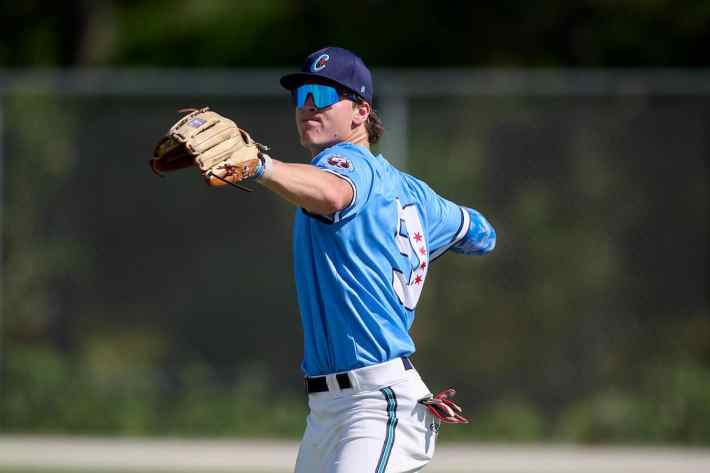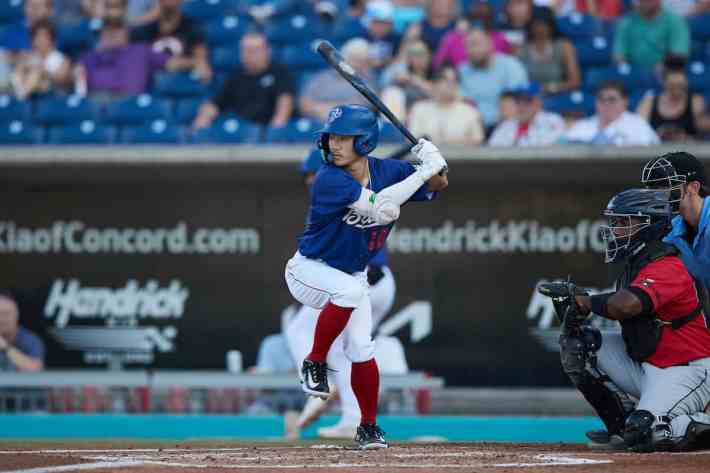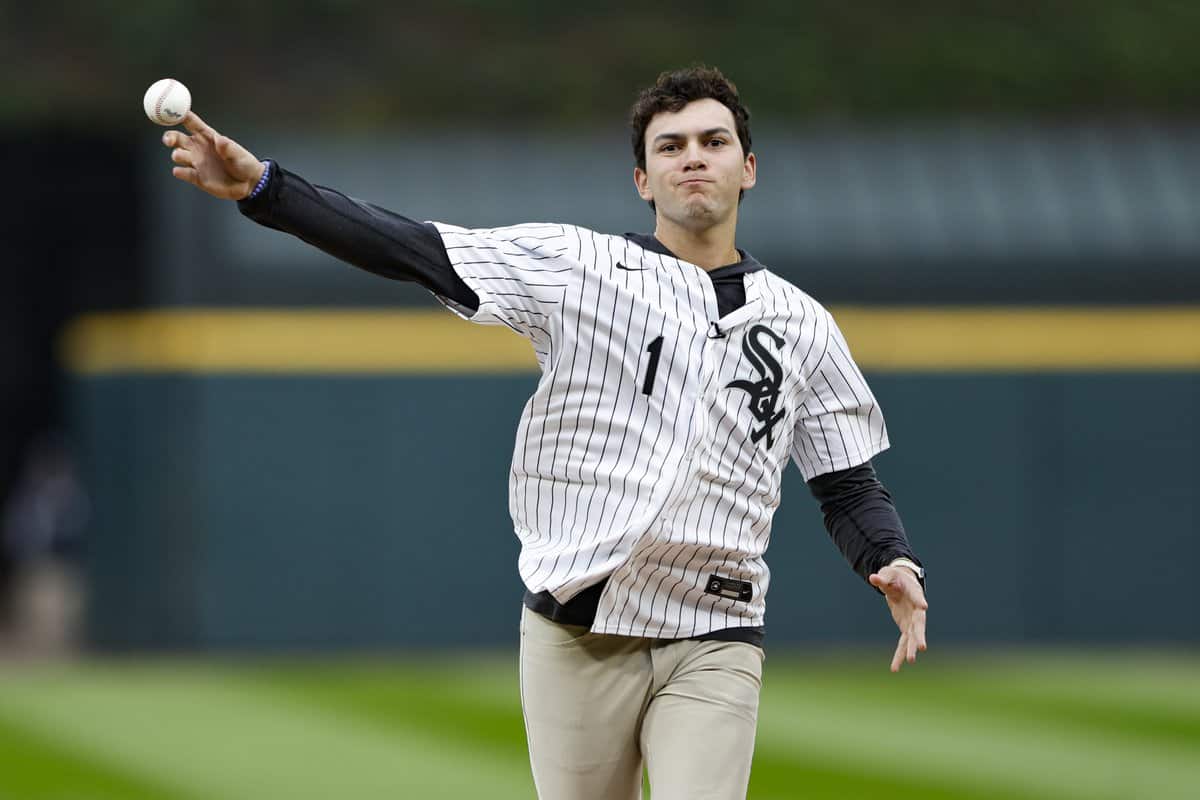Before Prospect Week continues with the newest crop of White Sox prospects -- 2023 draft picks and international signings -- we'd like to mention that the first installment now includes Ky Bush. The post covers White Sox prospects whose seasons were altered by injuries, and Bush's spring training lat strain certainly did enough to knock him off course.
Jacob Gonzalez
I’ve been covering the White Sox for too long to act brand new about a draft pick getting waylaid by his first half-season of professional baseball (.207/.329/.261 in 30 games at Low-A). Did you realize we were watching Jacob Gonzalez at the end of the longest season of his life? You know those first few months are really about getting acclimated to the professional routine anyway. And it really can’t be undersold how different it is swinging with a wood bat.
But I didn’t quite expect to trot out these well-traveled lines about Gonzalez. The White Sox social team surely expected to find better highlight clips than a rollover RBI groundout to second, and the amateur scouting department surely hoped a proven SEC performer would have a smoother transition at a level of competition college stars often dominate. Gonzalez himself admitted to reporters in September that he often hears doubts about his ability to stick at short because of his size and pedestrian speed. While his technical proficiency on defense gives him some chance to transcend his tools, that his bat is the laggard half of the skill set so far is not ideal.
While his strikeout/walk numbers were great, scouts saw Gonzalez unable to counter anything located on the outer half of the plate. There are plenty of dead pull hitters living out their days in mansions, but it’s saying something else that this deficiency was pronounced enough that Low-A pitchers were exploiting it. Good friend Eric Longenhagen of FanGraphs expressed some optimism that Gonzalez looked bulked up at instructional league, which could allow him to sell out less to turn-and-burn on the inner third. It’s a more reassuring rationalization to give that Gonzalez can bounce back than “he was still figuring out the new sleep schedule,” or any of the other stuff I wrote down when neither Gavin Sheets nor Jake Burger cracked a .750 OPS in Kannapolis in 2017.
Grant Taylor
Before anyone could render a verdict on giving Peyton Pallette $1.5 million after Tommy John surgery had wiped out his draft season, the White Sox were already back at it with Taylor. I’m suspicious that thinking the White Sox especially love players who flash a new level of performance in the Cape Cod League is akin to modern NBA fans who think it’s just their team that can’t hold big leads. But Taylor’s breakout in the Cape before blowing out at LSU couples it with a story reminiscent of Garrett Crochet’s scouting process.
Without an absurd showing at the Cape (30 strikeouts to two walks (!!) in 21 innings, Taylor was viewed as having reliever-level command, and his injury canceled plans to show proof of concept in the SEC. With the way command returns after Tommy John surgery, chances are that the jury will still be out this time next year.
Seth Keener
The White Sox selected Keener out of Wake Forest in the third round. Pair it with their offseason acquisition of former Wake Forest first-round pick Jared Shuster, and they might be able to reverse-engineer the Demon Deacons’ vaunted pitch lab. Take Keener by himself, and he was a slider-first reliever who showed enough improvement in command to start a number of games for Wake Forest, but couldn’t quite crack a stacked rotation.
The White Sox have far more starts to go around, and they used him in that capacity in his pro debut – albeit with a limited workload, coming off a full collegiate season. He crossed 80 innings over the course of the summer, so he’s in position for traditional starter usage. The idea is that his fastball has enough velocity and carry to be its own plus pitch when facing hitters multiple times in a game is more of a concern.
Calvin Harris
There’s a peculiar charm in Gonzalez and Harris teaming up after their days in Ole Miss to both post superlative plate discipline numbers (20 walks and 23 strikeouts in 130 trips to the plate) at Kannapolis that were starved for impact power. Despite his 12-homer breakout as a junior in Oxford, it’s viewed as a more permanent situation for Harris, whose pretty left-handed swing is geared for contact over power.
It’s also less damning for Harris because he’s a fourth-round pick, and even if his catching lacks any standout tools or throwing, it should be viable enough to envision a future as a backup who consistently provides viable at-bats twice per week. As they always say, if you fail to fully develop Carlos Pérez, you must try, try again.
Christian Oppor
The White Sox missed out on drafting Oppor in the 11th round in 2022, but oppor-tunity knocked once again, and the Sox seized the day. If Noah Schultz is any indication, Mike Shirley is drawn to hard-throwing Midwestern lefties, and Oppor’s mid-90s fastball drew plenty of attention in the Wisconsin prep ranks. Things like stamina and secondary stuff is where the work lies, although Oppor had a successful first five games in the ACL to get his pro career started on the right (left) foot. He doesn’t turn 20 until after the 2024 draft, so it wouldn’t be surprising if the Sox kept him in Arizona, at least to start the 2024 short season.

George Wolkow
If Wolkow was drafted by, let’s say, the Dodgers, it’s easy to imagine him disappearing into the obscurity of the Camelback Ranch backfields for another couple years and not being discussed again until scouts started raising alarm that someone built like, I dunno, Young Hagrid had figured out how to make consistent enough contact to immolate the Carolina League. Or if he was never discussed again, no one would fault the greatest development engine in the sport for trying their hand at a halfcourt shot.
Because Wolkow was drafted by his hometown White Sox, where tales of top of the scale power and genuine perennial All-Star ceiling are rare, he’s already been featured in team social media touting a bright future. Wolkow’s body is more athletic and his swing is more fluid than the typical doubts that his size (can you imagine getting into a shoving match in the Downers Grove North cafeteria line with someone who is 6-foot-7, 240 pounds?!?) inspires. And Wolkow the person is very matter of fact about the level of work necessary to make his dreams of stardom realistic, but for approach, recognition and pure rawness reasons, it still boils down to an oft-told story of a long, risky road to get his hit tool playable enough to enable to massive pop to show up in games.
As signing scout J.J. Lally told me last summer, the White Sox aren’t going to be signing any Aaron Judges in the market, so they need to at least try to build their own.
Mathias LaCombe
LaCombe was among the last of the White Sox’s 2023 draft picks to sign, but that’s because he had to fly in from his native France to put pen to paper. He’s only the second Frenchman to be selected in the draft, and he drew White Sox scouts to Cochise College in Arizona with a jump in stuff that resulted in 97 strikeouts against 14 walks over 67⅓ innings. He appeared in a World Baseball Classic game against Great Britain, so he’s at least experienced some stiffer competition, at least for an inning.
Like just about every player taken, he’s going to have to keep building on his stuff to stand out as even a relief prospect. Unlike every player taken, his experience has taken him from France’s baseball academy to a small junior college in Arizona, so the White Sox’s pitch lab should be a step up from what he’s seen so far.

Rikuu Nishida
Everyone loves the undersized slap-hitting, contact-oriented bat-handler who defies the scouting focus on loud tools by simply performing. Or at least everyone loves them when they’re third-day draft fliers who sign for $170,000 rather than when they’re the fourth overall pick in the draft amid an intentional three-year rebuild.
The rub is that this profile does not inspire much grace when there are gaps in performance. So with pre-existing skepticism that there is enough power to be a viable threat and Nishida unlikely to provide meaningful defensive value in the outfield, he probably can’t slug .278 at Kannapolis again and still get written about next year. Savor his batter's box calisthenics while you can.
Abraham Nunez
Not to be dismissive of the thousands of young men striving to realize their baseball dreams across the Dominican Republic, but if you have a whiff of high-level plate approach in the DSL, a .400 OBP should be your. Sure enough, Marco Paddy praised Nunez’s breaking ball recognition and feel for using the whole field, and a .299/.427/.442 line followed in his age-17 season.
That should keep him above water now, and ideally buys Nunez enough time to tap into the traditional lanky corner outfielder build that his former big leaguer father also touted. A summer spent on the backfields of Glendale should buy Nunez another season where the maturity of his game carries the day, but his power has to click for that to be relevant at the upper levels.
Stiven Flores
Fores, who signed out of Venezuela for $250,000, was billed as a potential power-hitting catcher by Baseball America, but hitting for power is the only thing Flores didn’t do in his pro debut in the DSL. He hit .391/.456/.477 with 15 walks against a measly seven strikeouts over 147 plate appearances, and while the DSL is a chore to score, his defensive stats are cleaner than most.
We’re scouting off the stat line here, and for all we know, he could be another Manuel Guariman, but after one short season in the DSL, there isn’t much more he could’ve done with it.
Luis Reyes
The White Sox’s highest-paid pitcher of the 2023 signing class got off to a miserable start, but he righted the ship after a midseason shift to the bullpen.
| Role | G | IP | H | BB | K | ERA | OPS |
|---|---|---|---|---|---|---|---|
| Starter | 9 | 15.1 | 27 | 19 | 21 | 14.09 | 1.339 |
| Reliever | 7 | 22.1 | 11 | 11 | 28 | 2.42 | .427 |
Reyes was regularly throwing three to four innings an appearance by the end of the season, so it’s not like the White Sox spent $700,000 of international money to attempt to fast-track a reliever (we think). The question is whether he showed enough to jump to stateside pitching next season.
Javier Mogollon
Nobody made more happen on the 2023 DSL White Sox than Mogollon, who led the team with homers (10), RBIs (42), slugging percentage (.582) and triples (two) while finishing second in doubles and stolen bases, so you could say the White Sox already got their $75,000 worth.
He generated all that power from a listed height and weight of 5-8 and 160 pounds. He played two-thirds of his game at second base, but his 108 innings at shortstop were errorless, which is no small feat in the DSL. That gives Mogollon something of a José Rodríguez origin story, except Rodríguez only slugged .401 in his Dominican debut at 17.
Adrian Gil
The first time the White Sox signed a 17-year-old Adrian Gil, he made two appearances before requiring Tommy John surgery, and returned to the DSL with an unimpressive seven games two years later.
The second coming of an Adrian Gil is off to a better start. He hit .340/.481/.517 with 11 doubles, five homers and more walks (25) than strikeouts (21). Either the White Sox figured out something with their international program last summer, or there will be a bunch of rude awakenings in Arizona come July.
Eduardo Herrera
The White Sox broke new ground for a traditional international signing when they landed Herrera in this year’s signing period for $1.8 million. The White Sox boasted that he broke Micker Adolfo’s record $1.6 million signing bonus for a non-Cuban, but just like Andrew Benintendi’s franchise record contract, it’s not exactly a reflection of sheer ambition and investment, but it’s a pivot worth acknowledging after the strategy of reserving that money for older Cubans hit a dead end. He’s a 17-year-old power-hitting infielder who has already grown out of shortstop, but his entire profile rests on his right-handed pop regardless.





